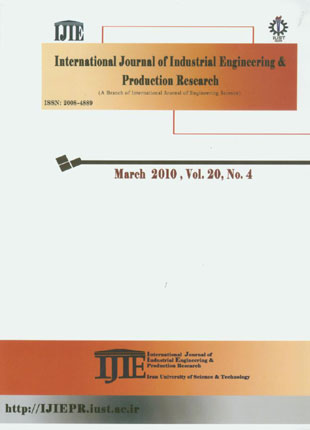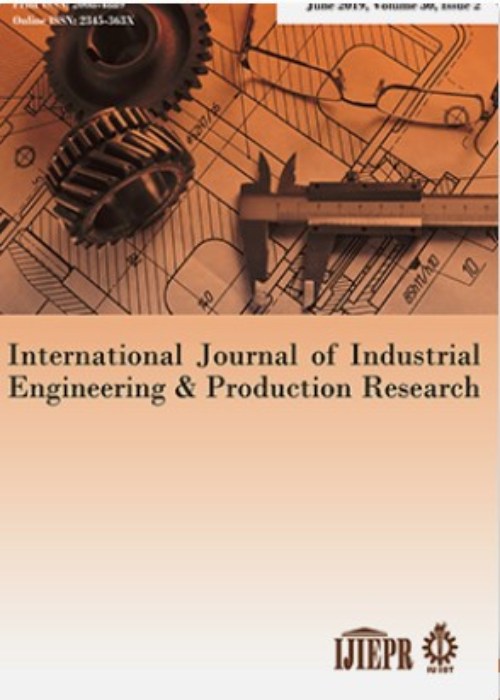فهرست مطالب

International Journal of Industrial Engineering and Productional Research
Volume:20 Issue: 4, Mar 2010
- تاریخ انتشار: 1389/01/15
- تعداد عناوین: 6
-
-
Page 135This paper is intended to provide a numerical algorithm based on random sampling for solving the linear Volterra integral equations of the second kind. This method is a Monte Carlo (MC) method based on the simulation of a continuous Markov chain. To illustrate the usefulness of this technique we apply it to a test problem. Numerical results are performed in order to show the efficiency and accuracy of the present method.
-
Page 139Nowadays, interval comparison matrices (ICM) take an important role in decision making under uncertainty. So it seems that a brief review on solution methods used in ICM should be useful. In this paper, the common methods are divided into four categories that are Goal Programming Method (GPM), Linear Programming Method (LPM), Non-Linear Programming Method (NLPM) and Statistic Analysis (SA). GPM itself is divided also into three categories. This paper is a review paper and is written to introduce the mathematical methods and the most important applications of ICM in decision making techniques.
-
Application of Analytic Network Process in Selection of Six-Sigma ProjectsPage 157
-
Page 165In today’s extremely competitive markets it is crucial for companies to strategically position their brands, products and services relative to their competitors. With the emerging trend in internationalization of companies especially SME’s and the growing use of the Internet with this regard, great amount of attention has been turned to effective involvement of the Internet channel in the marketing mix of the companies. This has introduced a new term of market space (the Web) versus the traditional battleground of marketplace in which companies compete with each other. The growth of presence in the market space has been exponential, both in general and within specific industries. Thus bringing to attention the importance of Web presence and that it is crucial for companies to strategically regard competition in market space. It is important to understand that positioning on the Net is very different and requires its own set of strategies as part of the new marketing paradigm. This study goes towards addressing the need to understand and measure the nature of positioning of company Web sites on the Internet. The aim of the study is to introduce a statistical technique to compare the positioning of Web sites, in and across industries. With this regard a group of Web sites from the home appliances manufacturing industry was selected and the technique of correspondence analysis was applied to produce maps which can be studied and interpreted. The results indicated that either based on company strategies or accidentally, these Web sites are positioned differently and may follow or affect different marketing policies of their owners. At the end, the implications of this technique for management and how it can be used by new home appliance manufacturers or those who want to compare their sites with the ones of their competitors, in order to benchmark and/or revise their policies and strategies have been discussed.
-
Page 177This paper aims at emphasizing the importance of establishing a Project Management (PM) system in Technology Transfer (TT) processes and developing a conceptual framework for it. TT is an important process in Technology Management affairs for all enterprises. Most of the time, lack of a particular concentration on technical, commercial and legal aspects of TT process, leads to mismanagement of other aspects of transferring project, like Time and Project Integration. This situation may lead to failure and loss of many opportunities in transfer process. To overcome this problem, inputs, outputs and activities of a typical TT processes are identified and based on these components, a conceptual framework for managing this project & prevent the loss is developed using Project Management models and methodologies.
-
Page 187Nowadays, in turbulent and violate global markets, agility has been considered as a fundamental characteristic of a supply chain needed for survival. To achieve the competitive edge, companies must align with suppliers and customers to streamline operations, as well as agility beyond individual companies. Consequently Agile Supply Chain (ASC) is considered as a dominant competitive advantage. However, so far a little effort has been made for designing, operating and evaluating agile supply chain in recent years. Therefore, in this study a new approach has been developed based on Adaptive Neuro Fuzzy Inference System (ANFIS) for evaluating agility in supply chain considering agility capabilities such as Flexibility, Competency, Cost, Responsiveness and Quickness. This evaluation helps managers to perform gap analysis between existent agility level and the desired one and also provides more informative and reliable information for decision making. Finally the proposed model has been applied to a leading car manufacturing company in Iran to prove the applicability of the model.


